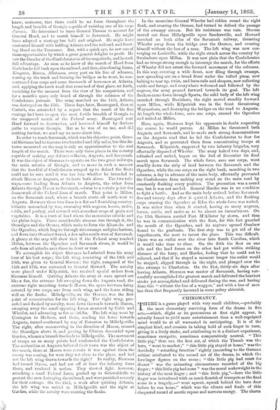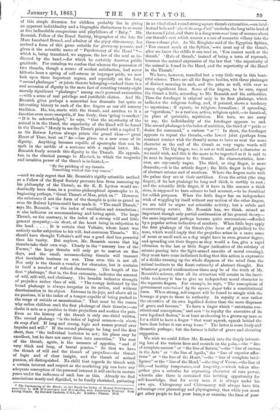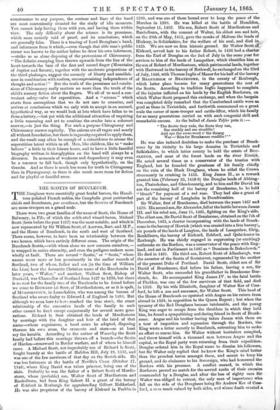CHIROMANC Y.
THERE is a game played with very small children,—probably 1 the most elementary surviving form of the drama in five acts,—which, slight as its pretensions at first sight appear, is actually found to yield more entertainment than a well-regi4ted mind would be at all warranted in anticipating. It is of the simplest kind, and consists in taking hold of each finger in turn, giving it a lively shake, and attributing to it a distinct experience, sometimes energetic, sometimes comparatively neutral. " This little pig," thus ran the first act, of which the Thumb was the hero, "went to market ;" "this little pig stayed at home," WM-the decidedly "retarding function" rightly (according to the German critics) attributed to the second act of the drama, in which the forefinger figures on the scene ; "this little pig had roast for dinner" was the animating circumstance recorded of the big finger; "this little pig had none" was the moral makeweight in the history of the next finger ; and "this little pig,"—here the little finger was introduced with as much flourish of trumpets as the final scene in a tragedy,—" went squeak, squeak behind the barn door before he ran home," which was the climax and finale of this chequered record of ascetic repose and nervous energy. The charm
of this simple diversion for children probably lies in giving an apparent individuality and a biographic distinctness to so many as five indissoluble companions and playfellows of "Baby." Mr. Beamish, Fellow of the Royal Society, biographer of the late Sir Marc Isambard Brunel, and admirer of the gipsy chiromancy, has revived a form of this game suitable for grown-up persons, and given it the scientific name of " Psychonomy of the Hand "*_
w hich is, being translated, we suppose, the law of the soul as in- dicated by the hand,—for which he certainly deserves public gratitude. For ourselves we confess that whereas the possession of two thumbs, though a source of modest satisfaction, had never hitherto been a spring of self-esteem or improper pride, we now look upon those important organs, and especially on the long "second phalanges" or joints thereto belonging—indeed there is a real accession of dignity in the mere fact of counting twenty-eight morally significant "phalanges" among one's personal extremities —with a sense of real privilege and justifiable elation. And Mr. Beamish gives perhaps a somewhat less dramatic but quite as interesting history to each of the five fingers as our old nursery tradition. He, too, starts with the thumb, and ascribes to it a function even more energetic, if less lively, than 'going to market.' " If it be acknowledged," he says, "that the superiority of the animal is in the Hand, the superiority of the Hand will be found in the Thumb." Merely to see the Thumb printed with a capital T, as Sir Bulwer Lytton always prints the grand ideas—" great Heart of Time, beat on !" &c.—has given us a new sense of its dignity. Anything becomes capable of apostrophe that can be spelt in the middle of a sentence with a capital letter. Mr. Beamish freely accords this dignity to the Thumb. He appeals, too, to the classical passage in Macbeth, in which the magnetic and intuitive power of the thumb is indicated,— " By the pricking of my thumbs
Something wicked this way comes," —and we only regret that Mr. Beamish's rigidly scientific method as a Fellow of the Royal Society prevents him from summing up his philosophy of the Thumb, as Sir E. B. Lytton would un- doubtedly have done, in a poetico-philosophical apostrophe to it, • beginning perhaps, "Great Thumb of Man, prick on !" However, the substance if not the form of the thought is quite as grand as -even Sir Bulwer Lytton could have made it. "The small Thumb," says Mr. Beamish, "is the index of vacillation and irresolution ; it also indicates an accommodating and loving spirit. The large Thumb, on the contrary, is the index of a strong will and little general sympathy,—in short, of the heart being in subjection to
the head It is certain that Voltaire, whose heart was entirely under subjection to his will, had enormous Thumbs." We Should have thought Voltaire's will was a good deal less powerful than his vanity. But anyhow, Mr. Beamish means that big thumbs take their own way. Clearly in the "nursery lore of the Future," the large thumbs will only go to market on fine days, and the small, accommodating thumbs will transact that inevitable business on wet. Then even this is not all. Not only is the thumb a voucher for character, but it contains in itself a number of refined distinctions. The length of the first "phalange," that is, the first extremity, indicates the amount of will, self-will, and obstinacy. The breadth indicates strength -of prejudice rather than of will. " The energy indicated by the broad phalange is always irregular in its action, and without discrimination in its object. Extreme in its joys, and above all in its passions, it is the index of a temper capable of being pushed to the verge of suicide or assassination." That must be the reason why sullen children suck the first phalange of their thumbs ;—no doubt it acts as a poultice to their prejudices and soothes the pain. Even so the history of the thumb is only one-third written. The second phalange "is the index of logical acumen—la clarte (la coup d'ceil. If long and strong, logic and reason prevail over impulse and will." If the second phalange be long and the first short, then "the individual hesitates to act ; his plans may be excellent, but he dare not carry them into execution." The root of the thumb, again, is the measure of appetite, "and if very thick and long, of brutal passion." So that we have the thumb of will and the thumb of prejudice--the thumb -of logic and of clear insight, and the thumb of animal passion, all distinguished. No child that regards its thumb with a certain interest and respect as the marketing pig can have any adequate conception of the personal interest it will excite in mature years under the influence of such lore as this. Already we find associations manly and dignified, to be fondly cherished, gathering * The Perhonomy of the Rand ; or, the Band the Index of Mental Development, Seem...ling to MM. D'Arpentigny and Desbarolles, with Illustrative Tracings from Living Hands. By Diehard Beamish, F.R.S., &e. London : Pitman. 1865. in an ideal cloud round strong square thumb extremities,—an intel- lectual halo and clarti du coup d'oeil' encircles the long table-land of the second joint, and there is a dangerous roué tone of menace about our thumb's root which weaves a sense of romantic villany into the three-volume plot. As Mr. Kinglake said of the Egyptian Sphinx, 'You cannot mock at the Sphinx,'—we must say of the thumb, after we know the riddle it can read us, 'You cannot mock at the thumb.' 'Rule of thumb,' instead of being a term of reproach, becomes the natural expression of the law that the superiority of the animal is found in the Hand, and the superiority of the Hand in the Thumb.'
We have, however, travelled but a very little way in this beau- tiful science. There are all the fingers besides, with three phalanges of distinct meaning in each, and the palm as well, with ever so many significant lines. Some of the fingers, to be sure, repeat the thumb a little, according to Mr. Beamish and his authorities. Thus the forefinger is original only in its first phalange, which indicates the religious feeling, and, if pointed, shows a tendency to mysticism ; if square, to religious formalism ; if spreading, or "spatulous," to a restless, active, religious spirit,—to fanatical, in place of quietistic, mysticism. But here, we are sorry to say, the individuality of the forefinger appears to end. The second phalange is the index of ambition, the third of "pride or desire for command," a curious " or " ! In short, the forefinger appears to repeat the thumbs, —the lowest joint (perhaps from constant contact with the thumb) seems to have as near the same character as the end of the thumb as very vague words will express. The big finger, too, is not so well marked a character as we could wish, and this is the more to be regretted as it is said to be next in importance to the thumb. Its characteristics, how- ever, are supremely vague. The third, or ring finger, is more dramatic,—it is the artistic finger ; the little finger is the finger of abstract science and of numbers. Where the fingers unite with the palms they are at their earthliest. Even the artist (the ring finger), if its last phalange be long and thick, is earthly in root ; and the scientific little finger, if it have in like manner a thick stem, is supposed to turn science to bad account,—to be Jesuitical for selfish purposes. When the little finger has an independent trick of waggling by itself without any motion of the other fingers, we are told to argue not scientific activity, but a subtle and manceuvring nature. Mr. Beamish has, we think, missed an important though only partial confirmation of his general theory— the more important perhaps because quite unconscious—afforded by a popular action indicative of mockery. When little boys apply the first phalange of the thumb (the locus of prejudice) to the nose, which would imply that the prejudice arises in a mere sense of scent or smell such as a dog might have in even greater degree, and spreading out their fingers as they would a fan, give a rapid vibration to the last or little finger (indicative of the subtlety of science passing into the light-armed assaults of moral cunning), they most have some indistinct feeling that this action is expressive of a dislike running up the whole diapason of the mind from the animal instincts to the finest extremity of abstract thought. But whatever general confirmations there may be of the truth of Mr. Beamish's science, after all its attraction will consist in the inevi- table tendency it has to give an independent moral character to the separate fingers. For example, he says, "The conceptions of government entertained by the square finger take a constitutional form. When strong, self-respect will be found to mingle with the homage it pays to those in authority. in royalty it sees rather
the executive of its own legalized desires than the mere dispenser of grace and favours." To have a finger which "entertains con- stitutional conceptions," and sees "in royalty the executive of its own legalized desires," is at least as cheering to a grown-up man as for a child to have a finger "that went squeak, squeak behind the barn door before it ran away home." The latter is more lively and dramatic perhaps ; but the former is fuller of grave and elevating suggestion.
We wish we could follow Mr. Beamish into the deeply interest- ing lore of the various lines and mounds on the palm,—the "line of complete success" or "the line of Saturn,"—the "line of success
in the Arts" or "the line of Apollo," the "line of superior affec- tions " or "the line of the Heart,"—the "line of complete intel-
ligence" or the "line of the Head,"—the ring of Venus,—the line of life,—of healthy temperance,—of longevity,—which taken alto- gether give a calculus for expressing character of rare power, wherein also there is contained this inviting opportunity for self-knowledge, that for every man it is always under his own eye. Chirognomy and Chiroinancy will always have this advantage over phrenology and physiognomy, that while you must get other people to feel your bumps or examine the lines of your
countenance to any purpose, the contour and lines of the hand are most conveniently situated for the study of idle moments. You cannot help having them with you, and having them within view. The only difficulty about the science is its premiss' es, which seem entirely void of proof, and its conclusions, which are generally false. There is a tracing of Lord Brougham's hand, and inferences from it which,—even though that able man's public career was known to the author before he drew his own inferences, —strike us as alone disposing of the pretensions of Chiromancy. "The definite sweeping lines thrown upwards from the line of the heart towards the base of the first and second finger (Mountains of Jupiter and Saturn), together with the moderate proportions of the third phalanges, suggest the anomaly of liberty and unselfish- ness in combination with restless, uncompromising independence of thought and action !" But the truth of the premisses and conclu- sions of Chiromancy really matters no more than the truth of the child's nursery fiction about the fingers. We all of us need a con- venient safety-valve for superstition. And a " science " which starts from assumptions that we do not care to examine, and arrives at conclusions which we only wish to accept in an amused, hypothetical way, as we would look at lots which have fallen to us from a lottery,—but yet with the additional attraction of requiring a little reasoning and art to combine the oracles into a coherent answer,—is just the thing. For such a purpose Chirognomy and Chiromancy answer capitally. The axioms are all vague and nearly all without foundation, but there is ingenuityrequired to apply them, and the result may often be enough of a coincidence to arouse the superstition latent within us all. Men, like children, like to "make believe" a little in their leisure hours, and to have a little fanciful biography written in hieroglyphics on the hand will always be a diversion. In momenta of weakness and despondency it may even be a resource to fall back, though only hypothetically, on the thumbs. And as there is much less room for truth in Chirognomy than in Physiognomy, so there is also much more room for fiction and for playful or fanciful error.
































 Previous page
Previous page